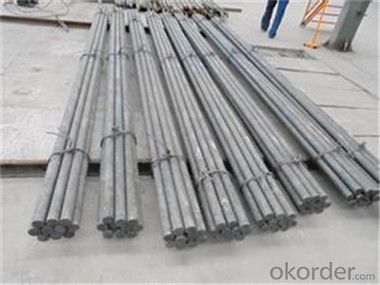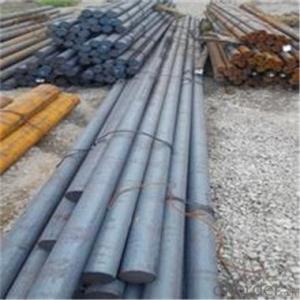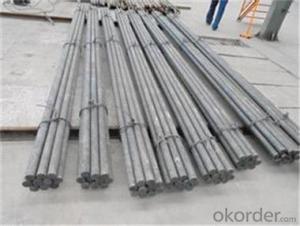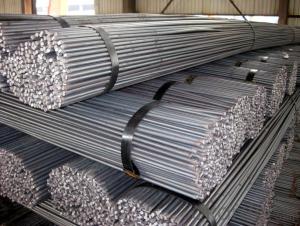Round Bar Manufacturer with Standard SKD11 High Quality
- Loading Port:
- Tianjin
- Payment Terms:
- TT OR LC
- Min Order Qty:
- 100 m.t.
- Supply Capability:
- 2000000 m.t./month
OKorder Service Pledge
OKorder Financial Service
You Might Also Like
Item specifice
Description of steel round bar:
(1) Thickness of not more than 2MM sheet, efficient blanking die, punch die and pressure die etc(2) All kinds of scissors, inserts, woodworking blade.
(3) Thread rolling die and wear-resistant slider.
(4) Cold Heading Die, thermosetting resin molding.
(5) Molding in deep drawing cold extrusion dies
Festures of steel round bar:
Mainly used for engineering component, forging industries, foundation bolt, shafting etc
We also stock RINL make rounds from 16mm to 80mm in all the available grades
We also take special orders in EN8, EN9 or any other equivalent grade with specific dimensional requirementsThe data given above in chart are indicative. Actual results may vary.
Specifications of steel round bar:
Description | steel round bar | |
Material | ASTM /AISI | 0,1065,1070,1080,1084 |
DIN | 5,1.7220,1.7218,1.7016,1.6523 | |
Standard | ,A575,BS970,DIN1652,JIS G4051 | |
cross section | Round Other shape:square | |
Surface | Black, galvanized,grinded,varnished,bare | |
Specifications | Round bar | Diameter: 12mm~650mm |
Angle bar | Size: 3mm*20mm*20mm | |
Square/ bar | Size: 4mm*4mm | |
Flat bar | Thickness: 2mm~100mm | |
Width:10mm~500mm | ||
Hexagonal | Size: 4mm~800mm | |
Length | Standard 6m,9m,12m or as required. | |
Trade terms | Payment terms | T/T,L/C,Western Union,negotiable etc. |
Price terms | FOB,CIF,CFR,EXW etc. | |
Applications | Hot rolled Steel round bars have a slightly grain textured finish. | |
Images of steel round bar:

FAQ:
1. What is your package?
Packing situation: standard seaworthy packing or as customer required.
2. How long is the lead time?
Delivery time: 45 days after order confirmed.
3. What payment term do you accept?
Payment: T/T or L/C at sight.
- Q:What is the difference between a forged and a ground steel round bar?
- A forged steel round bar and a ground steel round bar differ primarily in their manufacturing processes and resulting characteristics. A forged steel round bar is created by heating the steel to a high temperature and then shaping it using mechanical pressure, usually through a hammer or press. This process aligns the steel's grain structure, making it stronger and more durable. Forged steel round bars are known for their excellent strength, impact resistance, and overall toughness. They are commonly used in applications that require high strength, such as heavy machinery, automotive parts, and construction equipment. On the other hand, a ground steel round bar is manufactured through a grinding process. After the steel is initially shaped, it undergoes precision grinding to achieve the desired dimensions and surface finish. This process removes any imperfections or irregularities on the surface, resulting in a smooth and polished appearance. Ground steel round bars are often used in applications that require precise dimensions, such as shafts, axles, and precision tools. In summary, the main difference between a forged and a ground steel round bar lies in their manufacturing processes and resulting properties. A forged steel round bar offers superior strength and toughness due to its grain structure alignment, making it suitable for heavy-duty applications. On the other hand, a ground steel round bar is known for its precise dimensions and polished surface finish, making it ideal for applications that require precision.
- Q:What is the difference between carbon steel and alloy steel round bars?
- Both carbon steel and alloy steel round bars find extensive use across various industries, although they vary in terms of their composition and properties. In particular, carbon steel round bars consist predominantly of iron and carbon, with small amounts of other elements present. Depending on the grade, the carbon content typically ranges between 0.05% and 2.0%. These bars are renowned for their robustness and hardness, rendering them suitable for applications demanding high durability and resistance to wear. Additionally, carbon steel round bars possess excellent machinability, allowing them to be easily shaped and molded into desired forms. Nevertheless, they may exhibit limited resistance to corrosion, necessitating the application of additional protective coatings in corrosive environments. In contrast, alloy steel round bars are produced by incorporating various alloying elements into carbon steel. Such elements encompass manganese, chromium, nickel, molybdenum, and others. The inclusion of these elements augments the properties of the steel, including enhanced strength, toughness, and resistance to wear and corrosion. Alloy steel round bars are frequently selected for applications demanding specific characteristics, such as resistance to high temperatures, a high strength-to-weight ratio, or improved machinability. In conclusion, the primary disparity between carbon steel and alloy steel round bars lies in their composition and resulting properties. Carbon steel round bars primarily consist of iron and carbon, offering commendable strength and hardness; however, they may exhibit limited resistance to corrosion. Conversely, alloy steel round bars incorporate supplementary alloying elements, bolstering specific properties like increased strength, toughness, and corrosion resistance. The selection between carbon steel and alloy steel round bars hinges upon the precise requirements of the application at hand.
- Q:Can steel round bars be machined or forged?
- Steel round bars can indeed be machined or forged. Machining involves the utilization of cutting tools to extract material from the round bar, achieving the desired shape or dimension. This can be accomplished through a variety of methods, including turning, milling, drilling, or grinding. Machining is frequently employed in the creation of precise components or parts. On the flip side, forging entails heating the steel round bar and shaping it by applying compressive forces. This is typically accomplished using a hammer or press, deforming the material and creating the desired shape. Forging aids in the enhancement of the steel's mechanical properties, such as strength and toughness, by aligning the grain structure and eliminating any internal flaws. Both machining and forging techniques can be utilized to shape and manipulate steel round bars to meet specific requirements for various applications in industries like automotive, construction, energy, and manufacturing. The decision to employ machining or forging is contingent upon factors such as the complexity of the part, required tolerances, material properties, and the desired final product.
- Q:What are the different types of heat treatments applied to steel round bars?
- Steel round bars can undergo various heat treatments to enhance their mechanical properties and improve their performance in different applications. Some commonly used heat treatments include: 1. Annealing: Steel round bars are heated to a specific temperature and then slowly cooled. This process relieves internal stresses, improves ductility, and increases toughness. 2. Normalizing: Steel round bars are heated above the critical transformation point and then cooled in still air. Normalizing improves the structure and mechanical properties of the steel, making it more uniform and reducing residual stresses. 3. Quenching: Steel round bars are rapidly cooled by immersing them in a quenching medium like oil or water. This heat treatment transforms the austenite phase into martensite, increasing the hardness and strength of the steel. 4. Tempering: After quenching, the hardened steel round bars are reheated to a specific temperature and slowly cooled. Tempering reduces brittleness and improves toughness and ductility while maintaining an appropriate level of hardness. 5. Stress Relieving: This heat treatment is used to reduce residual stresses in the steel round bars that may have been introduced during previous manufacturing processes. The bars are heated to a temperature below the transformation point and slowly cooled. Stress relieving improves dimensional stability and reduces the risk of distortion or cracking. 6. Case Hardening: Carbon or nitrogen is introduced into the outer layer of the steel round bars, creating a hard and wear-resistant surface while maintaining a tough and ductile core. These examples illustrate the different heat treatments that can be applied to steel round bars. The choice of heat treatment depends on the desired mechanical properties and specific application requirements.
- Q:What are the different types of defects that can occur in steel round bars?
- Some common types of defects that can occur in steel round bars include surface defects such as cracks, pits, and scratches, as well as internal defects like inclusions, segregation, and porosity. Additionally, steel round bars can also experience dimensional defects such as ovality, taper, and straightness issues.
- Q:Are steel round bars suitable for electrical conductivity?
- Steel round bars are not typically known for their electrical conductivity. Steel is a good conductor of heat but has relatively poor electrical conductivity compared to other metals such as copper or aluminum. This is because steel is primarily composed of iron, which is a poor conductor of electricity. However, the electrical conductivity of steel can be improved by adding certain alloying elements such as chromium or nickel. These alloying elements can enhance the electrical conductivity of steel, making it more suitable for specific applications where electrical conductivity is required. Nonetheless, if high electrical conductivity is a critical requirement, other materials like copper or aluminum are usually preferred over steel round bars.
- Q:What are the advantages of using carbon steel round bars?
- Using carbon steel round bars in various applications offers several advantages. To begin with, carbon steel round bars are renowned for their exceptional strength and durability. They possess a high tensile strength, making them ideal for heavy-duty tasks that involve carrying substantial loads and enduring intense pressures. As a result, carbon steel round bars find extensive use in the construction, manufacturing, and engineering sectors. Another benefit of carbon steel round bars lies in their remarkable machinability. They can be effortlessly cut, drilled, and shaped into diverse forms, rendering them highly versatile for different projects. This flexibility allows for precise and accurate fabrication, ensuring that the desired specifications and dimensions are achieved. Furthermore, carbon steel round bars exhibit excellent weldability, enabling easy joining using various welding techniques. This feature makes them highly preferred for constructing structures and machinery that demand strong and secure connections. Moreover, carbon steel round bars offer a cost-effective solution compared to other materials with similar properties. They strike an optimal balance between performance and affordability, making them a favored choice across many applications. Additionally, their long lifespan and minimal maintenance requirements contribute to cost savings over time. Carbon steel round bars also possess a high resistance to corrosion and wear, thanks to the presence of carbon and other alloying elements. This enhanced resistance shields them from external factors like moisture, chemicals, and abrasion. Consequently, carbon steel round bars can endure harsh environments and prolonged exposure to various elements, making them well-suited for outdoor applications. Lastly, the widespread use and popularity of carbon steel round bars ensure their ready availability in the market. They can be found in various sizes, grades, and specifications, allowing users to select the most suitable option for their specific needs. This availability streamlines the sourcing process and reduces lead times for projects. In conclusion, the utilization of carbon steel round bars provides numerous advantages, including exceptional strength, excellent machinability, good weldability, affordability, corrosion resistance, and availability. These qualities establish carbon steel round bars as a reliable and versatile choice for a wide range of applications across different industries.
- Q:How is a steel round bar made?
- A steel round bar is made through a multi-step manufacturing process that involves several stages. The process begins with the selection of high-quality raw materials, typically steel billets, which are then heated in a furnace until they reach a specific temperature suitable for forging. Once the billet is heated, it is placed into a forging machine, where it is subjected to immense pressure to shape it into a round bar. The forging process involves repeatedly striking the billet with a hammer or applying pressure with a mechanical press until the desired shape and dimensions are achieved. After forging, the round bar is then subjected to a process called heat treatment, which involves heating the bar to a specific temperature and cooling it rapidly or slowly to enhance its mechanical properties. Heat treatment helps improve the bar's strength, hardness, and toughness, making it suitable for various applications. Next, the bar undergoes a process called machining, which involves cutting, turning, and grinding to achieve the desired dimensions and surface finish. This step ensures that the bar meets the required tolerances and specifications. Finally, the round bar is subjected to a final inspection to ensure its quality and adherence to the specified standards. This inspection involves checking its dimensions, surface finish, and any other specific requirements, such as chemical composition or mechanical properties. In summary, the production of a steel round bar involves the selection of high-quality raw materials, forging, heat treatment, machining, and final inspection. Each step in this process plays a crucial role in ensuring the quality and integrity of the final product.
- Q:Can steel round bars be used in the manufacturing of cylinders?
- Certainly, cylinders can be manufactured using steel round bars. Steel round bars are widely utilized across industries such as automotive, aerospace, and manufacturing owing to their exceptional strength and durability. When it comes to constructing the cylindrical body of a cylinder, steel round bars serve as an ideal material choice. The steel round bars can be shaped through machining, forging, or rolling, and subsequently joined together through welding or fastening to create the cylindrical structure. By employing steel round bars, the resulting construction guarantees robustness and stability, both of which are crucial for the secure and effective operation of cylinders in diverse applications.
- Q:Can steel round bars be used in the shipbuilding industry?
- Steel round bars have a wide range of applications in the shipbuilding industry. They are commonly used for constructing hulls, decks, bulkheads, and other structural components. The reason for their popularity lies in their exceptional strength, durability, and resistance to corrosion, which makes them well-suited for withstanding the harsh marine environment. In terms of fabrication, steel round bars can be easily welded, machined, and formed according to desired shapes, offering flexibility in ship construction. Furthermore, their availability in various sizes and grades allows for customization to meet specific shipbuilding requirements. Ultimately, steel round bars play a vital role in the shipbuilding industry due to their robustness and reliability.
1. Manufacturer Overview |
|
|---|---|
| Location | |
| Year Established | |
| Annual Output Value | |
| Main Markets | |
| Company Certifications | |
2. Manufacturer Certificates |
|
|---|---|
| a) Certification Name | |
| Range | |
| Reference | |
| Validity Period | |
3. Manufacturer Capability |
|
|---|---|
| a)Trade Capacity | |
| Nearest Port | |
| Export Percentage | |
| No.of Employees in Trade Department | |
| Language Spoken: | |
| b)Factory Information | |
| Factory Size: | |
| No. of Production Lines | |
| Contract Manufacturing | |
| Product Price Range | |
Send your message to us
Round Bar Manufacturer with Standard SKD11 High Quality
- Loading Port:
- Tianjin
- Payment Terms:
- TT OR LC
- Min Order Qty:
- 100 m.t.
- Supply Capability:
- 2000000 m.t./month
OKorder Service Pledge
OKorder Financial Service
Similar products
New products
Hot products
Related keywords































